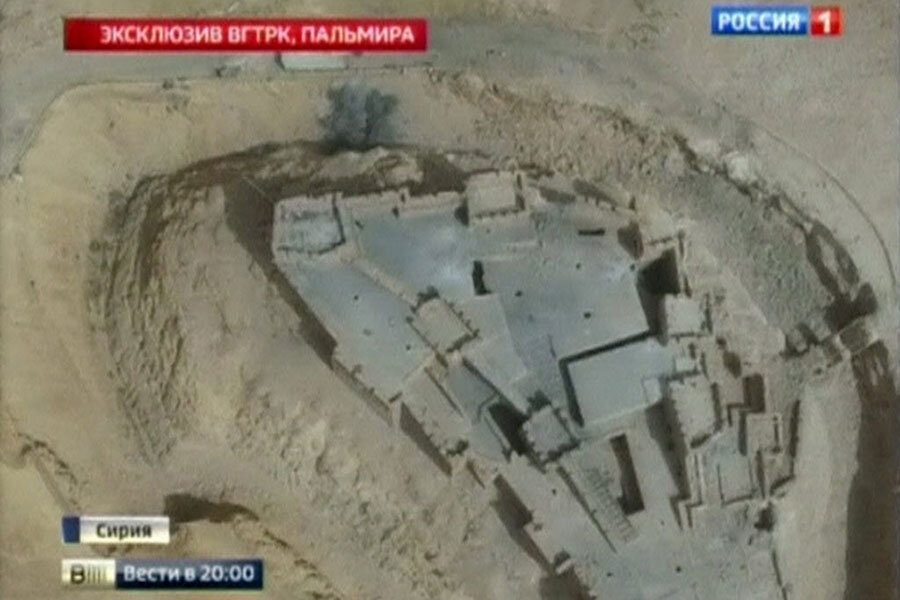Backed by Russian airstrikes, Syria works to retake Palmyra
Loading...
Syrian government forces backed by heavy Russian airstrikes have seized three neighborhoods inside Palmyra, a town with famed Roman-era ruins that fell to the Islamic State group last May, state media reported Saturday.
Russian jets carried out 40 air sorties near Palmyra in the past day, hitting 158 targets and killing over 100 militants, Russia's defense ministry said.
Syrian troops and allied militiamen have taken up positions in the three neighborhoods that are part of the modern town, according to Syrian Observatory for Human Rights, a Britain-based monitoring group.
Palmyra, affectionately known as the "bride of the desert," used to attract tens of thousands of tourists every year. IS drove out government forces in a matter of days and later demolished some of the best-known monuments in the UNESCO world heritage site. The extremists believe ancient ruins promote idolatry.
The militants also demolished the town's infamous Tadmur prison, where thousands of Syrian government opponents were reported to have been tortured.
Retaking the town would be a major victory for President Bashar Assad's government, which has made steady gains in recent months against IS and other insurgents.
The battle for Palmyra, now entering its fourth week according to the Observatory, has not been easy. Government forces lost at least 18 soldiers on Friday alone, including a major general, the Observatory and IS-affiliated media sites reported. The Observatory's figures indicate at least 56 soldiers have died in fighting this week.
Footage broadcast on Lebanese stations aligned with the Syrian government showed smoke rising over Palmyra's skyline, as tanks and helicopters fired at positions inside the town. IS began evacuating civilians this week to other parts of its territories in Syria. No civilians remain in the town, a Palmyra resident who left earlier this week told The Associated Press, speaking on condition of anonymity out of safety concerns.
The fate of the archaeological site was not immediately clear. Activists citing sources among advancing government forces said the two sides were fighting over the area, while the Observatory said government forces had retaken the site. Syrian state media made no mention of the area.
The head of Syria's antiquities and museums authority described the condition of the remaining monuments — including the grand amphitheater, the market place, public baths, and a long colonnade — as "excellent," with only minor damage, based on footage captured by a drone and broadcast on Russian television Friday.
Maamoun Abdulkarim, head of the government's antiquities and museums department, said civil servants are prepared to assess the monuments and plan for their restoration "as soon as we are given the green light from the Syrian army."
"We will present our studies to UNESCO so that Palmyra can once again be a world heritage site," said Abdulkarim. "Palmyra is not just for Syrians, it is for the world."
In addition to IS's destruction, a 2015 satellite study of Syria's numerous archaeological sites published in the journal Near Eastern Archaeology found evidence of widespread looting in areas controlled by government and opposition forces too.
If Syrian government forces retake Palmyra, they will be positioned to advance on the two largest Syrian cities held by IS, Deir Ezzor and Raqqa.
The IS group is on the back foot in Iraq and Syria, where forces on the ground have been backed by US-led airstrikes against the extremists. The U.S.-led international coalition estimates that the group has lost 40 percent of the territory it once held in Iraq and around 20 percent of its territory in Syria.
On Saturday, Turkish Air Force jets joined coalition forces in attacking IS in northern Iraq, hours after a Turkish soldier was killed at a military base in the region from rockets fired by the extremist militants.
Although Turkish jets have struck IS positions in Syria in the past, the attack marks Turkey's first aerial assault on the group in northern Iraq. In a statement carried by the state-run Anadolu Agency, Turkey's military said U.S.-led coalition war planes hit four IS positions in the region following the Bashiqa attack. The Turkish Air Force jets then joined the coalition air strikes, attacking and "destroying" four additional IS positions.
Ground forces in Iraq have been working to build on recent gains in Anbar province and preparing for an offensive on the northern city of Mosul, the largest city held by the militants.
IS militants have responded to territorial losses by launching a series of large attacks targeting civilians.
IS claimed responsibility for a suicide bombing on Friday at a small soccer stadium in the Iraqi city of Iskanderiyah, 30 miles (50 kilometers) from the capital, Baghdad.
The attack killed 41 people and wounded 105, security and health officials said. They spoke on condition of anonymity because they were not authorized to brief reporters.
Speaking at a press conference during an official visit to Iraq, U.N. Secretary General Ban Ki-Moon offered his condolences to the friends and families of those killed, adding that the "the international community stands with Iraqis in horror and outrage."







